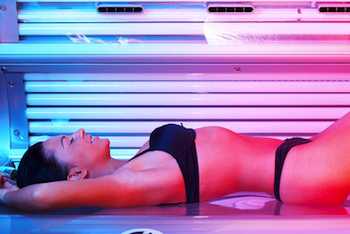- MENU
- HOME
- SEARCH
- WORLD
- MAIN
- AFRICA
- ASIA
- BALKANS
- EUROPE
- LATIN AMERICA
- MIDDLE EAST
- United Kingdom
- United States
- Argentina
- Australia
- Austria
- Benelux
- Brazil
- Canada
- China
- France
- Germany
- Greece
- Hungary
- India
- Indonesia
- Ireland
- Israel
- Italy
- Japan
- Korea
- Mexico
- New Zealand
- Pakistan
- Philippines
- Poland
- Russia
- South Africa
- Spain
- Taiwan
- Turkey
- USA
- BUSINESS
- WEALTH
- STOCKS
- TECH
- HEALTH
- LIFESTYLE
- ENTERTAINMENT
- SPORTS
- RSS
- iHaveNet.com: Health
Andrea Donsky and Randy Boyer

New study links indoor tanning to increased risk of melanoma
Summer's T-shirts, shorts and swimsuits mean two things: people want to look fit and tanned. It might seem like a good idea to book a little time at the tanning salon to work on your "base," but a new study out of the
The study, led by DeAnn Lazovich, an associate professor of epidemiology in the
Researchers found that people who use any type of tanning bed for any amount of time are 74 percent more likely to develop melanoma than people who've never used a tanning bed.
If you're a frequent tanning bed user, the risk is considerably higher. Researchers found frequent tanning bed users -- those who've logged 50 or more hours, have had more than 100 sessions, or have been using tanning beds for 10 or more years -- were 2.5 to 3 times more likely to develop melanoma than people who've never used a tanning bed.
The study also revealed the risks are similar regardless of whether the tanning device is a high-pressure UVA-emitting device, which emits about 99 percent or more UVA, or a UVB-enhanced or high-speed device, which emits higher proportions of UVB. (The sun, for comparison, emits 90 to 95 percent UVA and 5 to 10 percent UVB.)
Some experts have suggested UVB-enhanced devices can be safely used to help boost levels of vitamin D, particularly during the winter months in the northern U.S. and Canada. But this study indicates any amount of tanning with any device poses a significant risk.
"We found that it didn't matter the type of tanning device used; there was no safe tanning device," Lazovich said in a media release. "We also found -- and this is new data -- that the risk of getting melanoma is associated more with how much a person tans and not the age at which a person starts using tanning devices. Risk rises with frequency of use, regardless of age, gender, or device."
The study was able to definitively link melanoma to tanning bed use because it took into account other factors. "Most reports were not able to adjust for sun exposure, confirm a dose-response, or examine specific tanning devices," Lazovich said. "Our population-based, case-control study was conducted to address these limitations."
Melanoma is among the fastest increasing cancers in the U.S. and Minnesota. Only 4 percent of diagnosed skin cancers are melanoma, but it is responsible for 79 percent of deaths caused by skin cancer.
"The take-home message from our study is that indoor tanning is not safe," Lazovich said in a
"Indoor tanning use is an under-appreciated risk factor for melanoma," she said. "When we look at national data, we see that the proportion of women who report tanning indoors is actually higher than the proportion of women who report current smoking. And so I think that we really need to pay more attention to indoor tanning as a harmful practice that affects the health of our population, especially (among) young women."
But don't be so quick to trade in your tanning bed for a beach towel. Lazovich points out that the cancer risk for outdoor tanning is as high as with indoor tanning. "Ultra-violet radiation exposure should be avoided, whether it comes from indoor tanning or whether it comes from the sun," Lazovich said.
If you plan to be outdoors for more than 10 minutes, you should apply a broad-spectrum sunscreen (one that protects against both UVA and UVB radiation) with an SPF of at least 20. Look for natural brands, and consider avoiding products that contain retinyl palmitate, a form of vitamin A that is thought to benefit the skin but, according to preliminary
When you are outdoors, reapply sunscreen often (every two hours) and try to avoid too much sun exposure
Copyright © Naturally Savvy. All rights reserved.
AGING | ALTERNATIVE | AILMENTS | DRUGS | FITNESS | GENETICS | CHILDREN'S | MEN'S | WOMEN'S
Health - Indoor Tanning Definitively Linked to Deadliest Skin Cancer